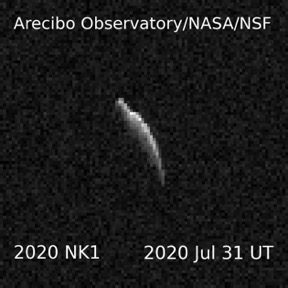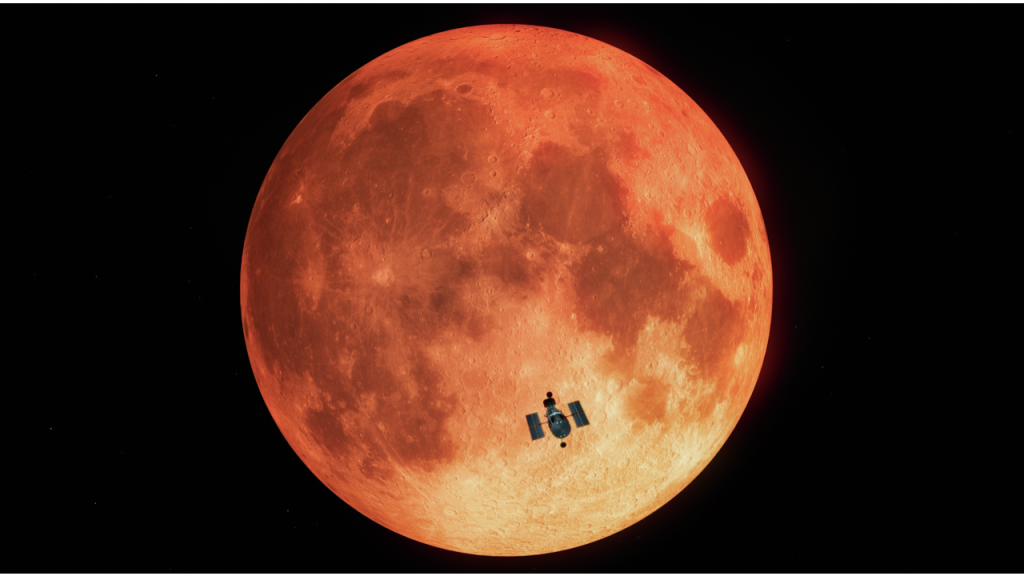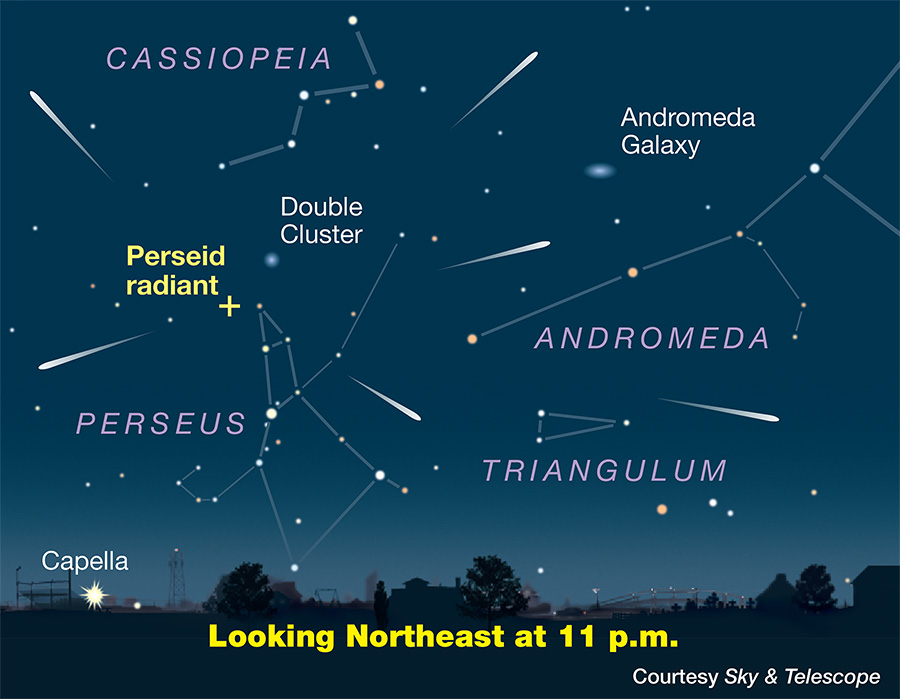Media
Transcript
Today’s top story is one that someday, some science fiction writer needs to use as inspiration for the third act of an asteroid attack story.
In early July, the Asteroid Terrestrial-impact Last Alert System, or ATLAS, discovered a potentially hazardous asteroid. This 1,600-foot-across space rock, cataloged as 2020 NK1, was calculated to have a one in 70,000 chance of striking Earth between 2086 and 2101. These early estimates suffered from a lack of data: with a better understanding of this asteroid’s orbit, we might learn the asteroid was never getting near or pin down the year it would try to kill us.

Asteroids are found using optical telescopes that look for their moving position in the sky. Their motion against the stars is enough to rough out what orbit they should be on, but because we can only see their motion in the plane of the sky, there are always going to be limitations.
To really know what’s going on, astronomers use one of the Earth’s massive radar telescopes. These systems bounce radio waves off the asteroids to determine their shape, rotation, and exact distance. The only catch is that the asteroids can only be analyzed by the likes of the Arecibo Observatory radio telescope and radar when they are within about five million miles of Earth or about 20 Earth-Moon distances. For this potentially dangerous asteroid, this kind of approach would happen on July 30-31, 2020.
While asteroid 2020 NK1 was bearing down on the Earth, Arecibo was being assaulted by Hurricane-turned-Tropical-Storm Isaias.
According to the University of Central Florida: The observatory shut down to prepare for the storm, and as soon as it passed the team jumped into action to detect and study the asteroid.
Observatory scientist Sean Marshall writes: Fortunately, the storm passed quickly without damage to the telescope or the radar system, and the maintenance and electronics teams were able to activate the telescope from hurricane lockdown in time for the observations.
For 2.5 hours, Arecibo radar imaged 2020 NK1, determining its precise shape, orbit, and motion. During subsequent analysis, it was determined that in 2043, this object will pass within 2.25 million miles of Earth – a distance that keeps it more than nine Moon distances from Earth. We’re safe. This time.
While fighting to get a telescope working the moment a storm abates may seem like extreme behavior when the potential danger is still decades away, right now is when we would need to start taking action if the object had been on a collision course. We have the ability to deflect asteroids with current technology, but all of our processes are slow and require a significant lead time to build the needed spacecraft and give them time to get their jobs done. I’m glad we’re safe from this asteroid, and I’m grateful to the team at Arecibo who rode out the storm at the telescope to get us this data.
Rarely do astronomers get to play action heroes in real life since most of what we do is far more mundane.
For instance, astronomers wanted to figure out how to see our Earth’s atmosphere the same way we see exoplanet atmospheres – by studying sunlight that has passed through the atmosphere and been altered in its passage. While it would have been super cool to fly a spacecraft with fancy instruments to a point in our solar system where it could watch the Earth transit the Sun, astronomers came up with a much more boring technique.

During the January 2019 lunar eclipse, astronomers pointed the Hubble Space Telescope at the Moon. The Moon passed into Earth’s shadow, and the only light bouncing off its surface was the sunlight that had passed through Earth’s atmosphere and light pollution from Earth that had scattered into space. This is consistent with the light we would see from an alien civilization during the transit of a planet across a star.
In studying the light reflected from the Moon, astronomers using Hubble were able to find signs of life on Earth; specifically, they were able to identify ozone. This three-oxygen molecule is most common where life of some form is producing oxygen. Left alone, oxygen will bond to other atoms, but ozone can be produced when nitrogen and oxygen are exposed to sunlight. This kind of detection quite accurately says that Earth has something oxygen-generating that could be life, but to definitively say there is life will require the detection of additional chemicals in Earth’s atmosphere. For now, the best Hubble can do is say Earth might contain life.
Trying to figure out what is going on in a star system is often a complex, many-telescope process.
In another case of more data makes for better understanding, astronomers have pointed the Atacama Large Millimeter/submillimeter Array’s (ALMA) inner cluster of 7-meter dishes at the Taurus Molecular Cloud and gone searching for points of future star formation. The compact array makes it possible to see faint smooth structures that might be missed with a higher resolution detector.

In a new paper in the Astrophysical Journal by K. Fujishiro and collaborators, 32 sites of star formation are described, and these systems vary ever so slightly in their star formation stage, allowing astronomers to capture how stars form, from gas collapse to the first hint of jet formation and onwards. These results are consistent with what we’ve seen in other star-forming regions, and by studying different systems, with slightly different masses and chemistries, we can better understand the details of how stars form in varied environments.
Before we go, we’d like to remind you that it is time to get out and see the Perseids. This particular meteor shower is one of the highlights of summer for many. It is visible in the early morning hours when it has the highest rate of visible “shooting stars” or meteors. This year, the Moon is going to try to interfere with our viewing, and you can see meteors, just not as frequently, early in the evening.

I’d recommend you get out, lay yourself out in a hammock or on a sleeping bag on the grass, coat yourself in bug spray, start looking up, and take in everything there is to see. You will see meteors streaking across the sky. They should increase in brightness as Perseus begins to rise. As I said, though, the Moon will also be rising and will interfere with your view. So get out early, catch it at the beginning, and stay out as long as you can tolerate the bugs and the moonlight shining.
We’ll be talking more about this shower tomorrow, but I wanted to make sure you knew that tomorrow morning is when you want to get out and look. You can also see the shower on Wednesday morning.
Learn More
Arecibo Observatory Returns from Tropical Storm Isaias Lockdown to Track Asteroid for NASA
Hubble Uses Earth as Proxy for Identifying Oxygen on Exoplanets
- Hubblesite press release
- Space Telescope Science Institute press release
- “The Hubble Space Telescope’s Near-UV and Optical Transmission Spectrum of Earth as an Exoplanet,” Allison Youngblood et al., 2020, Astronomical Journal
Stellar Egg Hunt with ALMA — Tracing Evolution from Embryo to Baby Star
- National Astronomical Observatory of Japan press release
- “FRagmentation and Evolution of Dense Cores Judged by ALMA (FREJA). I (Overview). Inner ~1,000 au Structures of Prestellar/Protostellar Cores in Taurus,” K. Tokuda et al., 2020 August 7, The Astrophysical Journal (Preprint on arxiv.org)
- “A Low-velocity Bipolar Outflow from a Deeply Embedded Object in Taurus Revealed by the Atacama Compact Array,” K. Fujishiro et al., 2020 August 7, The Astrophysical Journal Letters (Preprint on arxiv.org)
Prepare for the Perseids
Credits
Written by Pamela Gay
Hosted by Pamela Gay
Audio and Video Editing by Ally Pelphrey
Content Editing by Beth Johnson
Intro and Outro music by Kevin MacLeod, https://incompetech.com/music/


 We record most shows live, on Twitch. Follow us today to get alerts when we go live.
We record most shows live, on Twitch. Follow us today to get alerts when we go live.